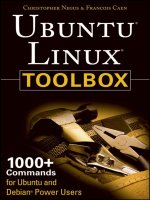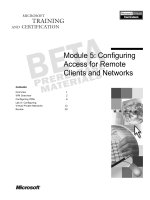inux Toolbox 1000 Commands for Fedora CentOS and Red Hat Power Users - Introduction
Bạn đang xem bản rút gọn của tài liệu. Xem và tải ngay bản đầy đủ của tài liệu tại đây (139.65 KB, 6 trang )
Introduction
After you’ve had some experience with Linux, you don’t need someone telling you to
click the Help button for help or to drag a file to the trash icon to delete it. What you
need is a reference that shows you powerful commands and options that let you take
hold of your Linux system, as well as the processes, users, storage media, network
resources, and system services associated with it.
Fedora Linux Toolbox provides you with more than 1,000 specific command lines to
help you become a Linux power user. Whether you are a systems administrator or
desktop user, the book will show you commands to create file systems, troubleshoot
networks, lock down security, and dig out almost anything you care to know about
your Linux system.
This book’s focus for your Linux command line journey is Fedora, the community-based
Linux distribution sponsored by Red Hat, Inc. Fedora and other Linux systems derived
from Fedora, such as Red Hat Enterprise Linux and CentOS, have been installed on
millions of computers around the world. Tapping into the skills needed to run those
systems can help you to work with your own Linux systems and to learn what you
need as a Linux professional.
Who Should Read This Book
This book is for anyone who wants to access the power of a Linux system as a systems
administrator or user. You may be a Linux enthusiast, a Linux professional, or possibly
a computer professional who is increasingly finding the Windows systems in your data
center supplanted by Linux boxes.
The bottom line is that you want to find quick and efficient ways of getting Fedora,
Red Hat Enterprise Linux, or CentOS systems working at peak performance. Those
systems may be a few desktop systems at work, a file and print server at your school,
or a home web server that you’re doing just for fun.
In the best case, you should already have some experience with Linux. However, if you
are a computer professional with skills managing other types of operating systems,
such as Windows, you should be able to easily adapt your knowledge to be able to use
the specific commands we cover in the book.
82911flast.qxd:Toolbox 10/18/07 4:04 PM Page xxi
Introduction
xxii
What This Book Covers
This is not a beginner’s Linux book. Before you jump in, it would be best if you have a
basic working knowledge of what Linux is, how the shell works, and what processes,
file systems, and network interfaces are. The book will then supplement that knowledge
with information you need to do the following activities:
❑ Get software — Fedora offers Package Updater (pup) and Package Management
(pirut) GUI tools for getting software. With tools such as
rpm
and
yum
, you’ll learn
the best ways to search for, download, install, update, and otherwise manage soft-
ware from the command line.
❑ Access applications — Find what’s available from massive Fedora software repos-
itories by searching yum repositories. Then search and download using tools from
the yum-utils package.
❑ Use the shell — Find neat techniques and tips for using the shell.
❑ Play with multimedia — Play and stream multimedia content from your computer.
You can also modify audio and image files, and then convert the content of those
files to different formats.
❑ Work with files — Use, manipulate, convert, and secure a wide range of file types
in Linux.
❑ Administer file systems — Access, format, partition, and monitor your file storage
hardware (hard disks, CD/DVD drives, floppy disks, USB flash drives, and so on).
Then create, format, and check the file systems that exist on those hardware devices.
❑ Back up and restore data — Use simple commands to gather, archive, and com-
press your files into efficient backup archives. Then store those archives locally
or on remote computers.
❑ Work with processes — List running processes in a variety of ways, such as by
CPU use, processor use, or process ID. Then change running processes to have
them run in the background or foreground. Send signals to processes to have them
re-read configuration files, stop and resume processing, or stop completely (abort).
❑ Manage the system — Run commands to check system resources, such as memory
usage, run levels, boot loaders, and kernel modules.
❑ Monitor networks — Bring wired, wireless, and dial-up network connections up
and down. Check routing, DNS, and host information. Keep an eye on network
traffic.
❑ Get network resources — Connect to Linux and Windows remote file systems
using FTP, NFS, and Samba facilities. Use shell-based commands to browse the Web.
❑ Do remote administration — Access and administer other computers using remote
login (ssh, telnet, and so on), and screen. Learn about remote administration inter-
faces, such as Webmin, SWAT, and CUPS.
82911flast.qxd:Toolbox 10/18/07 4:04 PM Page xxii
Introduction
xxiii
❑ Lock down security — Set up firewalls and system logging to secure your Linux
systems.
❑ Get reference information — Use the appendixes at the end of this book to get
more information about the shell (such as metacharacters and shell variables) and
the state of the system (from
/proc
).
Hopefully, if we have done it right, it will be easier to use this book than to Google for
the command lines or GUI tools you need.
After you have mastered many of the features described in this book, you’ll have gained
the following advantages:
❑ Hundreds of commands — By compressing a lot of information into a small space,
you will have access to hundreds of useful commands, in over 1000 command lines,
in a handy form to carry with you.
❑ Critical Linux information — This book lists connections to the most critical infor-
mation on the Web for succeeding with Linux in general and Fedora in particular.
❑ Transferable knowledge — Most of the same commands and options you use in
Fedora will work exactly the same way on other Linux systems. Different Linux
distributions, on the other hand, offer different graphical administration tools.
And even within a particular distribution, graphical tools change more often than
commands do.
❑ Quick problem solving — By the time others have started up a desktop and
launched a graphical administration tool, you will have already run a half dozen
commands and solved the problem.
❑ Enduring value — Many of the commands described in this book were used in
early Unix systems. So you are gaining tools that reflect the experience of thousands
of computer experts for more than 30 years.
Because the full documentation for commands used in Linux consists of thousands of
man pages, info text, and help messages, you will surely want to reach beyond the pages
of this book from time to time. Luckily, Fedora and other Linux systems include helpful
information installed on the system itself. Chapter 1 contains descriptions of how to
access that information that is probably already installed on your Fedora system.
How This Book Is Structured
This book is neither a pure reference book (with alphabetically listed components)
nor a guide (with step-by-step procedures for doing tasks). Instead, the book is organ-
ized by topics and aimed at including as many useful commands and options as we
could fit.
82911flast.qxd:Toolbox 10/18/07 4:04 PM Page xxiii
Introduction
xxiv
Chapter 1 starts by giving you a basic understanding of what Fedora is and how it
relates to other Linux systems, such as Red Hat Enterprise Linux and CentOS. Then it
describes some of the vast resources available to support your experience with this book
(such as man pages, info material, and help text). Chapter 2 provides a quick overview
of installation and then describes useful commands such as
rpm
and
yum
for getting and
managing your Fedora software.
Commands that a regular user may find useful in Linux are described in Chapters 3,
4, 5, and 6. Chapter 3 describes tools for using the shell, Chapter 4 covers commands
for working with files, and Chapter 5 describes how to manipulate text. Chapter 6 tells
how to work with music and image files.
Starting with Chapter 7, we get into topics relating to system administration. Creating
and checking file systems are covered in Chapter 7, while commands for doing data
backups are described in Chapter 8. Chapter 9 describes how to manipulate running
processes, and Chapter 10 describes administrative tools for managing basic compo-
nents, such as hardware modules, CPU use, and memory use.
Chapter 11 begins the chapters devoted to managing network resources by describing
how to set up and work with wired, wireless, and dial-up network interfaces. Chapter 12
covers text-based commands for web browsing, file transfer, file sharing, chats, and
e-mail. Tools for doing remote system administration are included in Chapter 13.
Chapter 14 covers how to lock down security using features such as firewalls and log-
ging. After that there are three appendixes that provide reference information for text
editing, shell features (metacharacters and variables), and system settings (from the
/proc
file system).
What You Need to Use This Book
Although we hope you enjoy the beauty of our prose, this is not meant to be a book
you curl up with in front of a nice fire with a glass of wine. We expect you will be sit-
ting in front of a computer screen trying to connect to a network, fix a file system, or
add a user. The wine is optional.
In other words, the book is meant to be a companion as you work on a Fedora, Red
Hat Enterprise Linux, or CentOS operating system. All of those systems are avail-
able for the x86 and x86_64 computer architectures. Some specific versions of those
systems are also available for IBM POWER (formerly known as PowerPC), SPARC,
Intel ia64 (Itanium), Alpha, and IBM mainframes. If you don’t already have one of
those systems installed, refer to Chapter 2 for information on getting and installing
those systems.
All of the commands in this book have been tested against Fedora 7 on x86 or x86_64
architecture. However, because many of these commands have been around for a long
82911flast.qxd:Toolbox 10/18/07 4:04 PM Page xxiv
time (some dating back over 30 years to the original Unix days), most will work exactly
as described here on RHEL, CentOS, and other Fedora derivative systems, regardless of
CPU architecture.
Many of the commands described in this book will work on other Linux and Unix sys-
tems as well. Because this book focuses on Fedora and other Red Hat–based distribu-
tions, descriptions will differ from other Linux systems most prominently in the areas
of packaging, installation, and GUI administration tools.
Conventions
To help you get the most from the text and keep track of what’s happening, we’ve used
a number of conventions throughout the book. In particular, we have created styles for
showing commands that allow us to fit as many command lines as possible in the book.
With command examples, computer output (shell prompts and messages) is shown in
regular monofont text, computer input (the stuff you type) is shown in bold monofont
text, and a short description (if included) appears in italics. Here is an example:
$ ls *jpg List all JPEG files in the current directory
hat.jpg
dog.jpg
...
To save space, output is sometimes truncated (or skipped altogether). Three dots (
...
)
are sometimes used to indicate that additional output was cut. If a command is par-
ticularly long, backslashes will appear at the end of each line to indicate that input is
continuing to the next line. Here is an example:
# oggenc NewSong.wav -o NewSong.ogg \
-a Bernstein -G Classical \
-d 06/15/1972 -t “Simple Song” \
-l “Bernsteins Mass” \
-c info=”From Kennedy Center”
In the example just shown, you can literally type the backslashes to have all that infor-
mation included in the single command. Or, you can simply put all the information on
a single line (excluding the backslashes). Notice that command prompts are shown in
one of two ways:
$ Indicates a regular user prompt
# Indicates the root prompt
As noted, when a dollar sign prompt (
$
) appears, any user can run the command.
With a pound sign prompt (
#
), you probably need to be the root user for the com-
mand to work.
Introduction
xxv
82911flast.qxd:Toolbox 10/18/07 4:04 PM Page xxv









